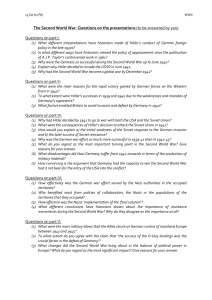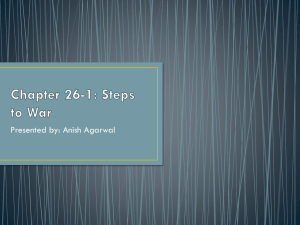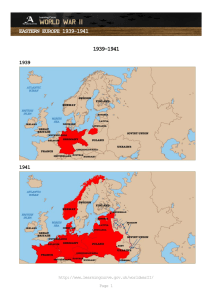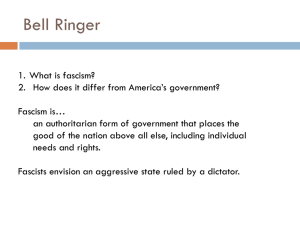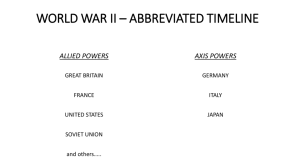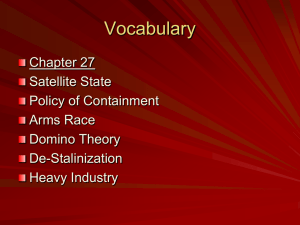Feeding the German Eagle: Soviet Economic Aid to Nazi Germany, 1933–1941
advertisement
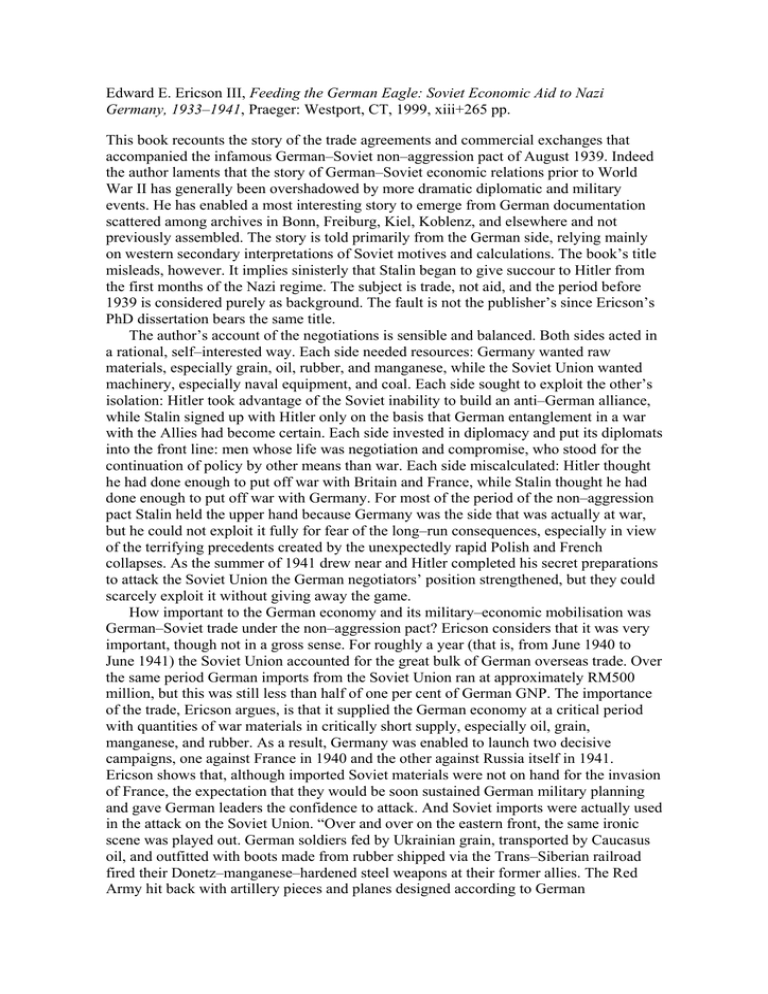
Edward E. Ericson III, Feeding the German Eagle: Soviet Economic Aid to Nazi Germany, 1933–1941, Praeger: Westport, CT, 1999, xiii+265 pp. This book recounts the story of the trade agreements and commercial exchanges that accompanied the infamous German–Soviet non–aggression pact of August 1939. Indeed the author laments that the story of German–Soviet economic relations prior to World War II has generally been overshadowed by more dramatic diplomatic and military events. He has enabled a most interesting story to emerge from German documentation scattered among archives in Bonn, Freiburg, Kiel, Koblenz, and elsewhere and not previously assembled. The story is told primarily from the German side, relying mainly on western secondary interpretations of Soviet motives and calculations. The book’s title misleads, however. It implies sinisterly that Stalin began to give succour to Hitler from the first months of the Nazi regime. The subject is trade, not aid, and the period before 1939 is considered purely as background. The fault is not the publisher’s since Ericson’s PhD dissertation bears the same title. The author’s account of the negotiations is sensible and balanced. Both sides acted in a rational, self–interested way. Each side needed resources: Germany wanted raw materials, especially grain, oil, rubber, and manganese, while the Soviet Union wanted machinery, especially naval equipment, and coal. Each side sought to exploit the other’s isolation: Hitler took advantage of the Soviet inability to build an anti–German alliance, while Stalin signed up with Hitler only on the basis that German entanglement in a war with the Allies had become certain. Each side invested in diplomacy and put its diplomats into the front line: men whose life was negotiation and compromise, who stood for the continuation of policy by other means than war. Each side miscalculated: Hitler thought he had done enough to put off war with Britain and France, while Stalin thought he had done enough to put off war with Germany. For most of the period of the non–aggression pact Stalin held the upper hand because Germany was the side that was actually at war, but he could not exploit it fully for fear of the long–run consequences, especially in view of the terrifying precedents created by the unexpectedly rapid Polish and French collapses. As the summer of 1941 drew near and Hitler completed his secret preparations to attack the Soviet Union the German negotiators’ position strengthened, but they could scarcely exploit it without giving away the game. How important to the German economy and its military–economic mobilisation was German–Soviet trade under the non–aggression pact? Ericson considers that it was very important, though not in a gross sense. For roughly a year (that is, from June 1940 to June 1941) the Soviet Union accounted for the great bulk of German overseas trade. Over the same period German imports from the Soviet Union ran at approximately RM500 million, but this was still less than half of one per cent of German GNP. The importance of the trade, Ericson argues, is that it supplied the German economy at a critical period with quantities of war materials in critically short supply, especially oil, grain, manganese, and rubber. As a result, Germany was enabled to launch two decisive campaigns, one against France in 1940 and the other against Russia itself in 1941. Ericson shows that, although imported Soviet materials were not on hand for the invasion of France, the expectation that they would be soon sustained German military planning and gave German leaders the confidence to attack. And Soviet imports were actually used in the attack on the Soviet Union. “Over and over on the eastern front, the same ironic scene was played out. German soldiers fed by Ukrainian grain, transported by Caucasus oil, and outfitted with boots made from rubber shipped via the Trans–Siberian railroad fired their Donetz–manganese–hardened steel weapons at their former allies. The Red Army hit back with artillery pieces and planes designed according to German 2 specifications and produced by Ruhr Valley machines in factories that burned coal from the Saar.” On one reading of subsequent history, Ericson mis–states the importance of German– Soviet trade in 1941. The Germans themselves overestimated the dependence of their military–economic mobilisation on imported war materials. Three years later, despite terrible losses and relentless bombardments, their economy would still be able to lift war production to three times the level of 1941. The lesson, as Mancur Olson once pointed out in a different context, is that in wartime there are no essential materials, only essential uses. In real, serious wars hardly any particular shortages turn out to be critical because something else can always be made to do instead, or, if not, it turns out to be possible simply to make do with less. There is a cost, but the cost is paid from incomes generally. In the end it is overall shortages that cripple, not particular ones. Ericson recognises the power of substitution to overcome particular shortages. After June 1941 Germany, having lost Soviet trade, turned to “conservation, synthetic production, and Speer’s efficiency drive”. He argues, correctly, that in the end “the German war economy and Hitler’s plans for world conquest were doomed to failure once the Russian campaign fell short of its ambitious goals” only by the superior wealth of the Allies. This argument could be extended logically to suggest that in 1940–1, on the other hand, Germany’s military–economic mobilisation was not yet seriously limited by resources. On the contrary it was saturated with resources, including labour: in 1941 output per worker in the war industries had fallen by a quarter in two years. The real immediate constraints were will–power and organisation. However, this need not mean that Soviet trade was unimportant; if in 1941 as in 1940, it supplied Hitler’s generals with the confidence to plan the invasion of Russia, it provided something even more important than mere oil or rubber. In short, this book is a timely and scholarly contribution to the history of World War II which will be welcomed by economic and military historians and students of international relations. Mark Harrison Professor of Economics University of Warwick Coventry CV4 7AL England Mark.Harrison@warwick.ac.uk
